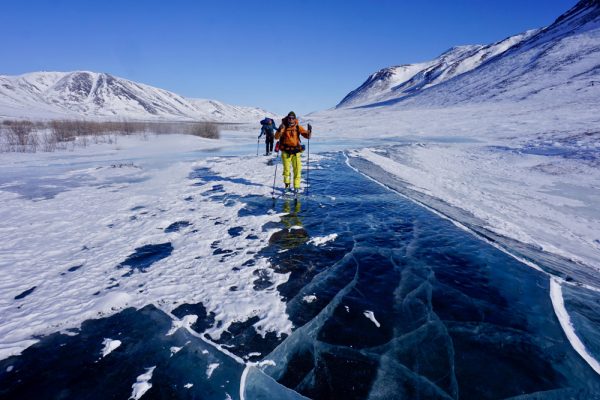Powering across Alaska on skis
May 3, 2018
Ned Rozell
907-474-7468

“Jeremy offers us only his incessant snoring to remind us that he is a man and not a god.”
So wrote Seth Adams on an Instagram post showing Jeremy Vandermeer striding across a wind-whipped ridge near the frozen headwaters of the Ambler River. Adams is a writer and photographer in Fairbanks who accompanied Vandermeer for a good portion of a recent 500-plus-mile ski traverse of Alaska.
Vandermeer is an engineer with the Alaska Center for Energy and Power at the University of Alaska Fairbanks. He teamed with Miles Raney, Adams and Bob Gillis in an attempt to ski from Galbraith Lake on the North Slope to Kotzebue on the Chukchi Sea, with much of the Brooks Range between the start and finish.
Gillis returned to Fairbanks from Anaktuvuk Pass and Adams flew back there from the village of Ambler.
Raney and Vandermeer started on April 1 and reached Kotzebue 20 days later. They skied into the windy village on the western coast a few days ahead of the date they had planned.
Vandermeer is 30 years old. He grew up in Ontario, Canada, but calls Fairbanks home. His face is coffee tanned and his hands are big as bear paws. Raney, a telecommunications technician from Palmer, had met Vandermeer on a race a year before.
“I was intrigued by Jeremy’s mellow disposition and strength,” he said. “Thanks to him, this trip was well thought-out and planned.”

Vandermeer was craving a long winter trip and dreamed up the east-to-west ski traverse of the Brooks Range. On April 1, he and his three partners — each wearing backpacks and carrying 2.5 pounds of food for each planned day — stepped out of cars and into blowing snow at Galbraith Lake.
They were joined by competitors in the Alaska Mountain Wilderness Classic Ski Race. Vandermeer and his friends signed up for the race with the permission of director Dave Cramer, who knew they would continue west from Anaktuvuk Pass, unlike the racers who would ski back to Wiseman.
After a few days, the skiers reached their mailed food box in the village of Anaktuvuk Pass. From there, they followed a snowmachine trail west to Chandler Lake, where villagers like to fish through holes in the ice. They then followed a trapline trail west and eventually reached a friend’s cabin at the headwaters of the Alatna River. There, they took a break for a day and ate like men who had been burning body fat for a week.
After crossing the Noatak, one of the great northern rivers, Vandermeer, Raney and Adams reached a grove of balsam poplars, the first trees they had seen in two weeks.
Soon after they encountered a steep canyon at the upper Ambler River. They were not sure they could descend. Backtracking from a snowy dropoff with a bottom they couldn’t see, they wandered a windy plateau looking for a way down.
“We thought it might be a no-go,” Vandermeer said.
After a bit more squinting into the wind, the trio found a pathway down that after a few hours led to the protection of some spruce trees. After a couple days descending the Ambler River, they followed a snowmachine trail to the village of Ambler.
Adams flew back to Fairbanks from Ambler. Vandermeer and Raney continued to Kotzebue along the Kobuk River, which had a nice trail with markers planted for the Kobuk 440 sled dog race. Along the way, Vandermeer and Raney met and ate lunch with one of their favorite authors, Seth Kantner, at his river home outside Ambler.
The skiing was good all the way from Ambler to Kotzebue. Vandermeer and Raney soon found themselves walking snow-covered gravel roads in their plastic boots.
They found a place to stay, took showers and stuffed themselves at a local restaurant. Vandermeer toured Kotzebue’s battery bank that backs up the village’s wind-power generation system.
They arrived early enough that Vandermeer, due to give a presentation at a conference in Kotzebue, instead returned to Fairbanks by commercial aircraft. He wanted to see his girlfriend, switch out of his ski clothes and sleep in his own bed.
This week, he returns to Kotzebue, this time via flight from Fairbanks to Anchorage to north of the Arctic Circle. In Kotzebue, he will give a talk at the Northern Regions Mining Summit. Vandermeer specializes on integrating solar and wind into diesel-powered microgrid systems typical of many Alaska villages, lodges and mines. He expects to talk with miners and show them examples of other remote power solutions.
Since the late 1970s, the University of Alaska Fairbanks' Geophysical Institute has provided this column free in cooperation with the UAF research community. Ned Rozell is a science writer for the Geophysical Institute.


